Launching the #CPUOverload Project: Testing Every x86 Desktop Processor since 2010
by Dr. Ian Cutress on July 20, 2020 1:30 PM ESTGaming Tests: GTA 5
The highly anticipated iteration of the Grand Theft Auto franchise hit the shelves on April 14th 2015, with both AMD and NVIDIA to help optimize the title. At this point GTA V is super old, but still super useful as a benchmark – it is a complicated test with many features that modern titles today still struggle with. With rumors of a GTA 6 on the horizon, I hope Rockstar make that benchmark as easy to use as this one is.
GTA doesn’t provide graphical presets, but opens up the options to users and extends the boundaries by pushing even the hardest systems to the limit using Rockstar’s Advanced Game Engine under DirectX 11. Whether the user is flying high in the mountains with long draw distances or dealing with assorted trash in the city, when cranked up to maximum it creates stunning visuals but hard work for both the CPU and the GPU.
We are using the following settings:
- 720p Low
- 1440p Low
- 4K Low
- 1080p Max
For our test we have scripted a version of the in-game benchmark. The in-game benchmark consists of five scenarios: four short panning shots with varying lighting and weather effects, and a fifth action sequence that lasts around 90 seconds. We use only the final part of the benchmark, which combines a flight scene in a jet followed by an inner city drive-by through several intersections followed by ramming a tanker that explodes, causing other cars to explode as well. This is a mix of distance rendering followed by a detailed near-rendering action sequence, and the title thankfully spits out frame time data. The benchmark can also be called from the command line, making it very easy to use.
There is one funny caveat with GTA. If the CPU is too slow, or has too few cores, the benchmark loads, but it doesn’t have enough time to put items in the correct position. As a result, for example when running our single core Sandy Bridge system, the jet ends up stuck at the middle of an intersection causing a traffic jam. Unfortunately this means the benchmark never ends, but still amusing.
| AnandTech | IGP | Low | Medium | High |
| Average FPS |  |
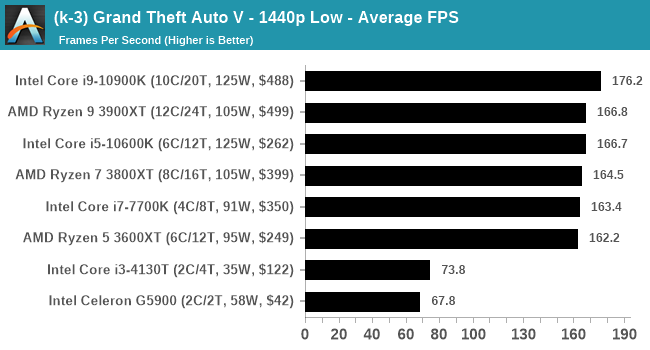 |
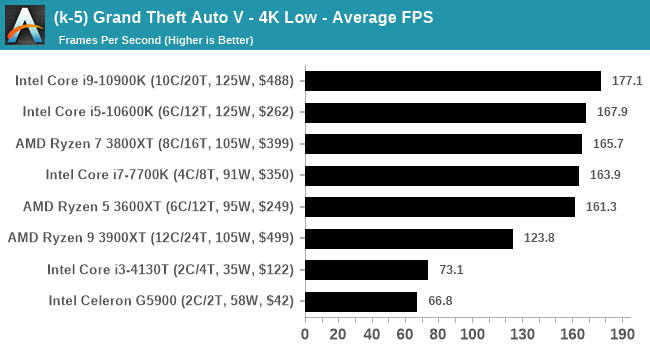 |
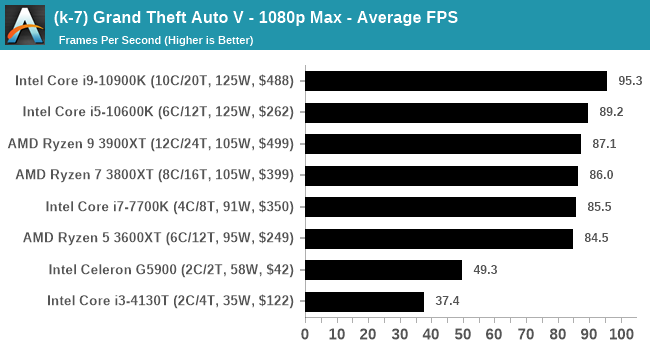 |
| 95th Percentile | 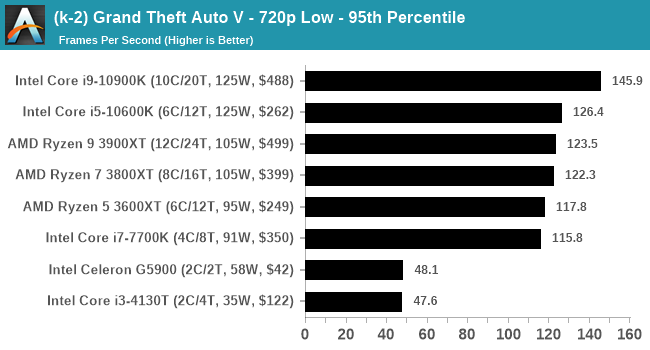 |
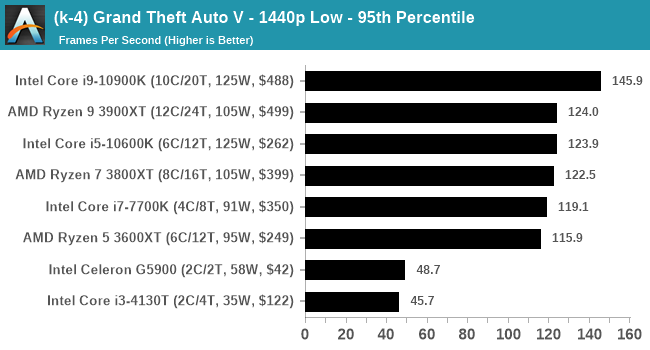 |
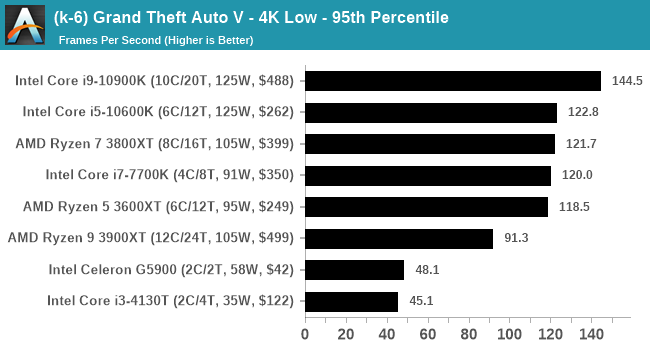 |
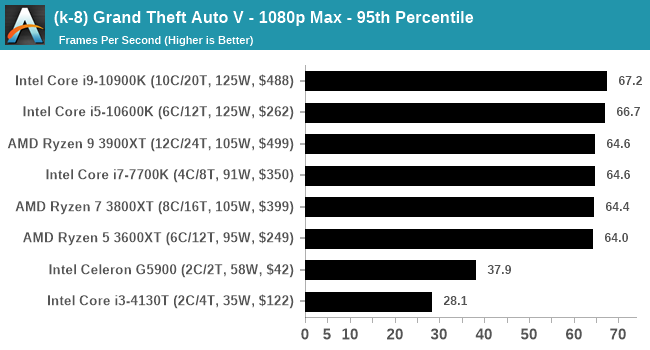 |
All of our benchmark results can also be found in our benchmark engine, Bench.


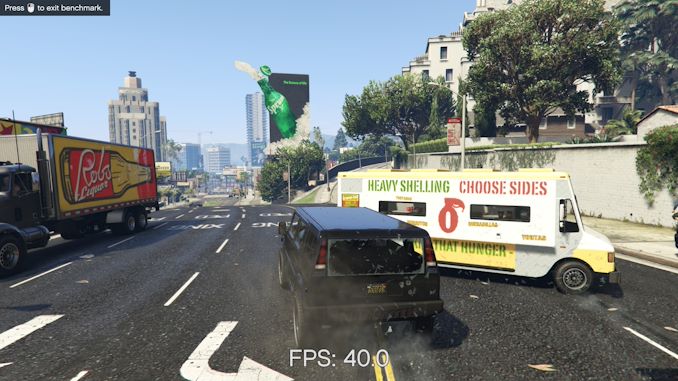









110 Comments
View All Comments
Arbie - Monday, July 20, 2020 - link
I din't realize how much work was being done. Thank you for maintaining this great resource.Arbie - Monday, July 20, 2020 - link
And maybe consider the technically excellent and easily benchmarked Ashes of the Singularity instead of the problematic Far Cry 5. Not as popular but modern and multi-core (and a great game).BushLin - Monday, July 20, 2020 - link
I suspect it's due to Far Cry 5's need for 8 threads which manifests in stutter for 6c6t CPUs in contrast to smooth gameplay on lower clocked 4c8t CPUs.Tilmitt - Tuesday, July 21, 2020 - link
Has anyone ever played Ashes as a game though?Arbie - Tuesday, July 21, 2020 - link
1000+ hours so far. Glorious in all respects including phenomenal AI. But when Ashes is mentioned someone always pops a comment like yours, which they probably just read somewhere else since it certainly isn't based on actual experience. Still hurts the game, though.driscoll42 - Monday, July 20, 2020 - link
This is awesome and amazing, I can't wait to see the results. And I hate to say "But what about", but maybe, if possible, go back to some of the popular older ones? No need to retest *everything*, but the most popular CPUs pre-2010 like the i7-920, Core 2 Quad Q6600, Core 2 Duo E8600, Core i7-870, etc...ltcommanderdata - Monday, July 20, 2020 - link
If they are going to test a few LGA 775 CPUs, I'd vote to also include NetBurst's last gasp, aka the Pentium Extreme Edition 965 as a really old gen reference. It'd be interesting to include it's then competitor, the Socket 939 AMD Athlon 64 FX-60, as well. I've always been curious whether Hyperthreading support allowed the Pentium EE 965 to age better than expected as multithreading became mainstream and possibly reduce the gap against the FX-60 and even early Core 2 Duo Conroe CPUs in modern software compared to the gap seen at launch.mganai - Thursday, July 23, 2020 - link
How about the dual socket LGA 771 with two Core 2 Extreme QX9650s?https://www.youtube.com/watch?v=wNo7qoLRtkQ
aryonoco - Monday, July 20, 2020 - link
Epic work Ian. Epic!Now if only your publisher implemented a subscription model (a la Ars Technica) so I could still support your work withthout being bombarded by ads and tracked, I would feel a lot less guilty enjoying the fruits of your amazing work.
lmcd - Tuesday, July 21, 2020 - link
This 100%